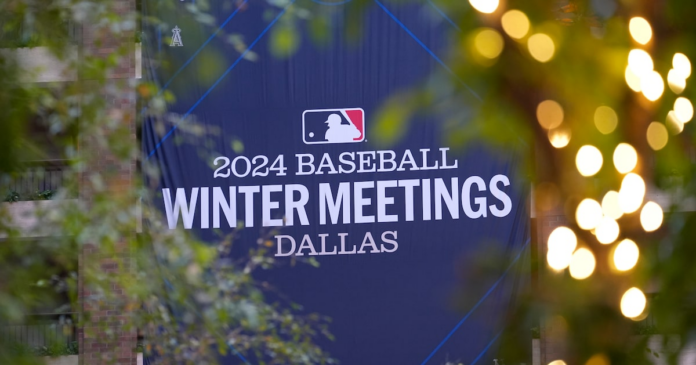The Winter Meetings first came to Dallas in 1980 and have returned just about once a decade ever since. Always at the Anatole, whether it flew under the Loews or Hilton flag.
It was at the Anatole that Tom Hicks famously bid against himself to get Alex Rodriguez to agree to that 10-year, $252 million contract with the Rangers that so many viewed as a harbinger of doom for the baseball industry. A decade later, in Dallas, Albert Pujols fled St. Louis for the West Coast for 10 years and $240 million. It, too, was viewed as a sign of doom.
Now, both the contracts and the sentiments seem quaint.
All we know is that the meetings keep coming back to Dallas and the contracts keep growing and the only thing we seem to learn is that nobody makes it out of a 10-year-deal with his current club. So, guess the only mystery still to be solved on Juan Soto’s $765 million, 15-year deal with the Mets is exactly where he will ultimately play out the last two years when he’s in his 40s.
Rangers Be the smartest Rangers fan. Get the latest news. SIGN UP Or with: Google Facebook By signing up you agree to our Terms of Service and Privacy Policy
While we wandered aimlessly through Anatole’s lobby and amid its sculptures, here are five things we think we learned:
What’s next for the Rangers
The Rangers were one of the most active teams at the winter meetings, re-signing Nathan Eovaldi, trading for Jake Burger and signing reliever Jacob Webb. The next move would probably be to sign a high-leverage arm for the back of the bullpen. Experience in the closer’s role can only help, Chris Young indicated this week. A reunion with Kirby Yates is still possible.
Advertisement
With the Rangers wanting to keep the payroll below the CBT threshold of $241 million, they only have about $27 million to work with to add another two or three bullpen arms and the left-handed bat that Young would like. In order to make a bigger splash in the bullpen or with the bat (perhaps Joc Pederson), it may require the Rangers to create a little more financial flexibility. And the trade for Burger sure seems to make Nathaniel Lowe’s expected $10 million arbitration salary stand out. It might make sense to move Lowe and reallocate the money to other still-pressing needs.
The other option is a potential lineup that might look like this: CF Evan Carter, SS Corey Seager, 2B Marcus Semien, RF Adolis Garcia, LF Wyatt Langford, 3B Josh Jung, 1B Nathaniel Lowe, DH Jake Burger, C Jonah Heim. With a bench of Josh Smith, Ezequiel Duran, Kyle Higashioka and Leody Taveras. That’s stacked with weapons, depth and versatility.
Advertisement
Solving Sasaki
A day after Japanese pitcher Roki Sasaki was officially posted, his agent, Joel Wolfe, was asked about some factors that might impact Sasaki’s decision. A smaller market might, in Wolfe’s estimation, make it a bit easier for Sasaki to fit in. An older Japanese teammate might help, as well. Or maybe not. From our interpretation, it made it sound a lot like San Diego might be the frontrunner, but there were certainly reasons to believe the Rangers had a legitimate shot. Also: We can’t help but think Seattle will also make a strong case for itself, though the Mariners don’t have a recent deep playoff run to cite as success. They do, however, have an already strong pitching staff, and the presence of Ichiro Suzuki around the organization can’t be overlooked.
Advertisement
Maybe this really is it for the Astros
We’ll admit it. We’ve been among the voices that suggested the end of Astros dominance for the last couple of years, mostly incorrectly. Over the last 10 seasons, Houston has gone to the postseason eight times, at least as far as the ALCS seven times, to the World Series four times and twice walked off with Commissioner’s Trophy. But it really feels different now with Alex Bregman unlikely to return in free agency and growing momentum toward trading Kyle Tucker and perhaps Framber Valdez. The Astros seem to certainly be posturing like a team ready to re-tool.
Baseball ain’t going broke
With the current CBA set to expire after 2026, expect to hear about economic stresses that will make it absolutely necessary for owners to impose some type of salary cap or more severe deterrents to spending. TV broadcasting rights will almost certainly be cited. Yeah, well, don’t believe it. The Mets gave Juan Soto a $765 million contract, blowing by the previous record contract for a player by $65 million. And in truth, with all the deferrals, Shohei Ohtani’s deal last year was worth more like $465. So it was more like a $300 million jump. Us? If you can get it, you are worth it. And it’s pretty clear guys can get it. Over four days, between agreements and actual signings, baseball owners committed more than $1.4 billion in money to free agents.
Advertisement
Baseball ain’t broke, either, so don’t try to fix it
You know what everyone’s reaction to the floated idea of adding a “Golden At-Bat,” to the list of rules changes? C’mon, man. Get serious. There seemed to be little support for the idea among executives and industry insiders. The plain truth is that most of the slew of rule changes over the past few years had some kind of practical application. The three-batter rule for relievers, pitch clock and limiting throw-overs have helped speed up the game without detracting from its core. The extra-inning rule may be a little funky, but it creates less stress, particularly on catchers and keeps rosters a little more stable. The seemingly universal reaction to the GAB was: It would be gimmickry.
Find more Rangers coverage from The Dallas Morning News here.
Advertisement
Click or tap here to sign up for our Rangers newsletter.


